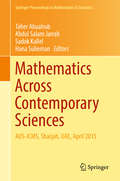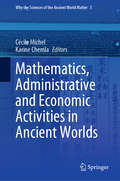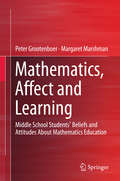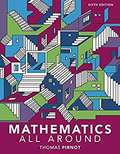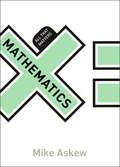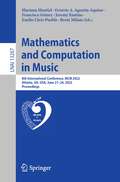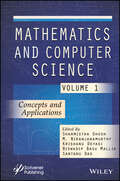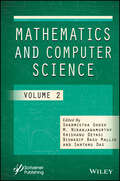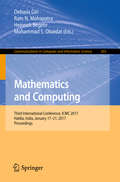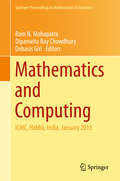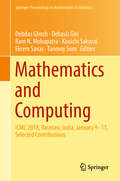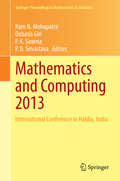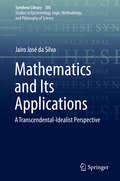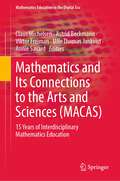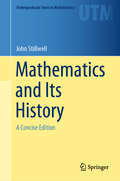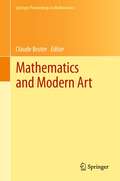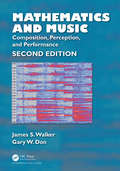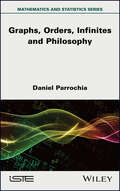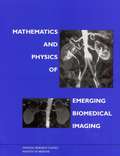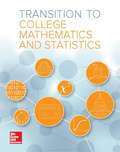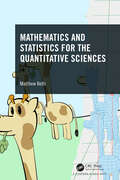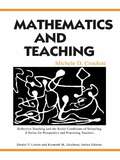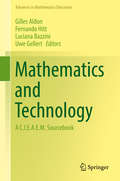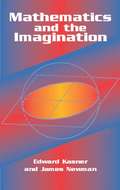- Table View
- List View
Mathematics Across Contemporary Sciences
by Taher Abualrub Abdul Salam Jarrah Sadok Kallel Hana SuliemanThis work presents invited contributions from the second "International Conference on Mathematics and Statistics" jointly organized by the AUS (American University of Sharjah) and the AMS (American Mathematical Society). Addressing several research fields across the mathematical sciences, all of the papers were prepared by faculty members at universities in the Gulf region or prominent international researchers. The current volume is the first of its kind in the UAE and is intended to set new standards of excellence for collaboration and scholarship in the region.
Mathematics, Administrative and Economic Activities in Ancient Worlds (Why the Sciences of the Ancient World Matter #5)
by Cécile Michel Karine ChemlaThis book focuses on the ancient Near East, early imperial China, South-East Asia, and medieval Europe, shedding light on mathematical knowledge and practices documented by sources relating to the administrative and economic activities of officials, merchants and other actors. It compares these to mathematical texts produced in related school contexts or reflecting the pursuit of mathematics for its own sake to reveal the diversity of mathematical practices in each of these geographical areas of the ancient world. Based on case studies from various periods and political, economic and social contexts, it explores how, in each part of the world discussed, it is possible to identify and describe the different cultures of quantification and computation as well as their points of contact. The thirteen chapters draw on a wide variety of texts from ancient Near East, China, South-East Asia and medieval Europe, which are analyzed by researchers from various fields, including mathematics, history, philology, archaeology and economics. The book will appeal to historians of science, economists and institutional historians of the ancient and medieval world, and also to Assyriologists, Indologists, Sinologists and experts on medieval Europe.
Mathematics, Affect and Learning
by Peter Grootenboer Margaret MarshmanThis book examines the beliefs, attitudes, values and emotions of students in Years 5 to 8 (aged 10 to 14 years) about mathematics and mathematics education. Fundamentally, this book focuses on the development of affective views and responses towards mathematics and mathematics learning. Furthermore, it seems that students develop their more negative views of mathematics during the middle school years (Years 5 to 8), and so here we concentrate on students in this critical period. The book is based on a number of empirical studies, including an enquiry undertaken with 45 children in Years 5 and 6 in one school; a large-scale quantitative study undertaken with students from a range of schools across diverse communities in New Zealand; and two related small-scale studies with junior secondary students in Australia. This book brings substantial, empirically-based evidence to the widely held perception that many students have negative views of mathematics, and these affective responses develop during the middle years of school. The data for this book were collected with school students, and students who were actually engaged in learning mathematics in their crucial middle school years. The findings reported and discussed here are relevant for researchers and mathematics educators, policy makers and curriculum developers, and teachers and school principals engaged in the teaching of mathematics.
Mathematics All Around
by Tom PirnotGiven their widely varying backgrounds, students in Liberal Arts Math often enter the course with math anxiety. Pirnot’s Mathematics All Around, 6th Edition offers the supportive and patient writing style that students need to overcome that apprehension, developing useful skills through realistic applications that can be seen in the world around them. Relevant and approachable, the author’s tone resembles the support students would receive during an instructor’s office hours. The author emphasizes a problem-solving approach, reinforcing problem-solving methods and how to apply them throughout the text. The 6th Edition keeps students engaged with updated real-world applications, while also providing more support as they learn with new measurable objectives, revised exercise sets, significant enhancements to each chapter, as well as a new student Workbook.
Mathematics: All That Matters (All That Matters)
by Mike AskewMathematics often gets a bad press. Describing someone as 'calculating' or 'rational' is hardly as flattering as being labelled 'artistic' or 'creative' and mathematicians in movies or novels are often portrayed as social misfits who rarely get the guy or girl. No wonder some folks say 'oh I don't care for mathematics, I was never any good at it' with a wistful sense of pride. Yet professional mathematicians talk of the subject differently. They look for elegant solutions to problems, revel in playing around with mathematical ideas and talk of the creative nature of mathematics. As the Russian mathematician Sophia Kovalevskaya said "It is impossible to be a mathematician without being a poet in soul."So why is there such a gap between the views of everyday folks and professional mathematicians? Part of the problem lies in how most of us were taught mathematics in school. The mathematics served up there is presented as a series of de-contextualised, abstract ideas, wrested from the human struggles and interactions that gave birth to the ideas. Through looking at some of the history of mathematics, psychological studies into how we come to know mathematics and key ideas in mathematics itself, the intent of this book is, if not to make the reader fall in love with mathematics, then at least to come to understand its nature a little better, and perhaps care a little more for it. In short, this book explores the human side of maths.
Mathematics and Computation in Music: 8th International Conference, MCM 2022, Atlanta, GA, USA, June 21–24, 2022, Proceedings (Lecture Notes in Computer Science #13267)
by Mariana Montiel Octavio A. Agustín-Aquino Francisco Gómez Jeremy Kastine Emilio Lluis-Puebla Brent MilamThis book constitutes the thoroughly refereed proceedings of the 8th International Conference on Mathematics and Computation in Music, MCM 2022, held in Atlanta, GA, USA, in June 2022. The 29 full papers and 8 short papers presented were carefully reviewed and selected from 45 submissions. The papers feature research that combines mathematics or computation with music theory, music analysis, composition, and performance. They are organized in Mathematical Scale and Rhythm Theory: Combinatorial, Graph Theoretic, Group Theoretic and Transformational Approaches; Categorical and Algebraic Approaches to Music; Algorithms and Modeling for Music and Music-Related Phenomena; Applications of Mathematics to Musical Analysis; Mathematical Techniques and Microtonality
Mathematics and Computer Science, Volume 1
by Sharmistha Ghosh M. NiranjanamurthyMATHEMATICS AND COMPUTER SCIENCE This first volume in a new multi-volume set gives readers the basic concepts and applications for diverse ideas and innovations in the field of computing together with its growing interactions with mathematics. This new edited volume from Wiley-Scrivener is the first of its kind to present scientific and technological innovations by leading academicians, eminent researchers, and experts around the world in the areas of mathematical sciences and computing. The chapters focus on recent advances in computer science, and mathematics, and where the two intersect to create value for end users through practical applications of the theory. The chapters herein cover scientific advancements across a diversified spectrum that includes differential as well as integral equations with applications, computational fluid dynamics, nanofluids, network theory and optimization, control theory, machine learning and artificial intelligence, big data analytics, Internet of Things, cryptography, fuzzy automata, statistics, and many more. Readers of this book will get access to diverse ideas and innovations in the field of computing together with its growing interactions in various fields of mathematics. Whether for the engineer, scientist, student, academic, or other industry professional, this is a must-have for any library.
Mathematics and Computer Science, Volume 2
by Sharmistha Ghosh M. Niranjanamurthy Krishanu Deyasi Biswadip Basu Mallik Santanu DasMATHEMATICS AND COMPUTER SCIENCE This second volume in a new multi-volume set builds on the basic concepts and fundamentals laid out in the previous volume, presenting the reader with more advanced and cutting-edge topics being developed in this exciting field. This second volume in a new series from Wiley-Scrivener is the first of its kind to present scientific and technological innovations by leading academicians, eminent researchers, and experts around the world in the areas of mathematical sciences and computing. Building on what was presented in volume one, the chapters focus on more advanced topics in computer science, mathematics, and where the two intersect to create value for end users through practical applications. The chapters herein cover scientific advancements across a diversified spectrum that includes differential as well as integral equations with applications, computational fluid dynamics, nanofluids, network theory and optimization, control theory, machine learning and artificial intelligence, big data analytics, Internet of Things, cryptography, fuzzy automata, statistics, and many more. Readers of this book will get access to diverse ideas and innovations in the field of computing together with its growing interactions in various fields of mathematics. Whether for the engineer, scientist, student, academic, or other industry professional, this is a must-have for any library.
Mathematics and Computing
by Debasis Giri Ram N. Mohapatra Heinrich Begehr Mohammad S. ObaidatThis book discusses recent developments and contemporary research in mathematics, statistics and their applications in computing. All contributing authors are eminent academicians, scientists, researchers and scholars in their respective fields, hailing from around the world. This is the second conference on mathematics and computing organized at Haldia Institute of Technology, India. The conference has emerged as a powerful forum, offering researchers a venue to discuss, interact and collaborate, and stimulating the advancement of mathematics and its applications in computer science. The book will allow aspiring researchers to update their knowledge of cryptography, algebra, frame theory, optimizations, stochastic processes, compressive sensing, functional analysis, complex variables, etc. Educating future consumers, users, producers, developers and researchers in mathematics and computing is a challenging task and essential to the development of modern society. Hence, mathematics and its applications in computing are of vital importance to a broad range of communities, including mathematicians and computing professionals across different educational levels and disciplines. In current research, modeling and simulation, making decisions under uncertainty and pattern recognition have become very common. Professionals across different educational levels and disciplines need exposure to advances in mathematics and computing. In this context, this book presents research papers on applicable areas of current interest. It also includes papers in which experts summarize research findings, such as signal processing and analysis and low-rank-matrix approximation for solving large systems, which will emerge as powerful tools for further research. These new advances and cutting-edge research in the fields of mathematics and their applications to computing are of paramount importance for young researchers.
Mathematics and Computing
by Ram N. Mohapatra Dipanwita Roy Chowdhury Debasis GiriThis book discusses recent developments and contemporary research in mathematics, statistics and their applications in computing. All contributing authors are eminent academicians, scientists, researchers and scholars in their respective fields, hailing from around the world. This is the second conference on mathematics and computing organized at Haldia Institute of Technology, India. The conference has emerged as a powerful forum, offering researchers a venue to discuss, interact and collaborate, and stimulating the advancement of mathematics and its applications in computer science. The book will allow aspiring researchers to update their knowledge of cryptography, algebra, frame theory, optimizations, stochastic processes, compressive sensing, functional analysis, complex variables, etc. Educating future consumers, users, producers, developers and researchers in mathematics and computing is a challenging task and essential to the development of modern society. Hence, mathematics and its applications in computing are of vital importance to a broad range of communities, including mathematicians and computing professionals across different educational levels and disciplines. In current research, modeling and simulation, making decisions under uncertainty and pattern recognition have become very common. Professionals across different educational levels and disciplines need exposure to advances in mathematics and computing. In this context, this book presents research papers on applicable areas of current interest. It also includes papers in which experts summarize research findings, such as signal processing and analysis and low-rank-matrix approximation for solving large systems, which will emerge as powerful tools for further research. These new advances and cutting-edge research in the fields of mathematics and their applications to computing are of paramount importance for young researchers.
Mathematics and Computing: Icmc, Haldia, India, January 2015 (Springer Proceedings in Mathematics & Statistics #139)
by Tanmoy Som Ekrem Savas Kouichi Sakurai Ram N. Mohapatra Debasis Giri Debdas GhoshThis book discusses recent advances and research in applied mathematics, statistics and their applications in computing. It features papers presented at the fourth conference in the series organized at the Indian Institute of Technology (Banaras Hindu University), Varanasi, India, on 9 – 11 January 2018 on areas of current interest, including operations research, soft computing, applied mathematical modelling, cryptology, and security analysis. The conference has emerged as a powerful forum, bringing together leading academic scientists, experts from industry, and researchers and offering a venue to discuss, interact and collaborate to stimulate the advancement of mathematics and its applications in computer science. The education of future consumers, users, producers, developers and researchers of mathematics and its applications is an important challenge in modern society, and as such, mathematics and its application in computer science are of vital significance to all spectrums of the community, as well as to mathematicians and computing professionals across different educational levels and disciplines. With contributions by leading international experts, this book motivates and creates interest among young researchers.
Mathematics and Computing 2013
by Ram N. Mohapatra Debasis Giri P. K. Saxena P. D. SrivastavaThis book discusses recent developments and contemporary research in mathematics, statistics and their applications in computing. All contributing authors are eminent academicians, scientists, researchers and scholars in their respective fields, hailing from around the world. The conference has emerged as a powerful forum, offering researchers a venue to discuss, interact and collaborate and stimulating the advancement of mathematics and its applications in computer science. The book will allow aspiring researchers to update their knowledge of cryptography, algebra, frame theory, optimizations, stochastic processes, compressive sensing, functional analysis, complex variables, etc. Educating future consumers, users, producers, developers and researchers in mathematics and computing is a challenging task and essential to the development of modern society. Hence, mathematics and its applications in computer science are of vital importance to a broad range of communities, including mathematicians and computing professionals across different educational levels and disciplines.
Mathematics and Its Applications: A Transcendental-Idealist Perspective (Synthese Library #385)
by Jairo José da SilvaThis monograph offers a fresh perspective on the applicability of mathematics in science. It explores what mathematics must be so that its applications to the empirical world do not constitute a mystery. In the process, readers are presented with a new version of mathematical structuralism.The author details a philosophy of mathematics in which the problem of its applicability, particularly in physics, in all its forms can be explained and justified. Chapters cover: mathematics as a formal science, mathematical ontology: what does it mean to exist, mathematical structures: what are they and how do we know them, how different layers of mathematical structuring relate to each other and to perceptual structures, and how to use mathematics to find out how the world is.The book simultaneously develops along two lines, both inspired and enlightened by Edmund Husserl’s phenomenological philosophy. One line leads to the establishment of a particular version of mathematical structuralism, free of “naturalist” and empiricist bias. The other leads to a logical-epistemological explanation and justification of the applicability of mathematics carried out within a unique structuralist perspective. This second line points to the “unreasonable” effectiveness of mathematics in physics as a means of representation, a tool, and a source of not always logically justified but useful and effective heuristic strategies.
Mathematics and Its Connections to the Arts and Sciences: 15 Years of Interdisciplinary Mathematics Education (Mathematics Education in the Digital Era #19)
by Claus Michelsen Astrid Beckmann Viktor Freiman Uffe Thomas Jankvist Annie SavardThis book celebrates the 15th anniversary of the bi-annual symposium series Mathematics and its Connections to the Arts and Sciences (MACAS), which was first held in 2005 following the continued collaboration of an international group of researchers from ICME Topic Study Group 21. The MACAS-conferences bring together scientists and educators who are interested in the connection between mathematics, arts and science in educational curriculum, while emphasizing on, as well as researching about, the role of mathematics. By pooling together these different approaches and viewpoints between mathematics, arts and sciences, this book reveals possible synergies and paths for collaborations. In view of the challenges of the 21st century, a modern approach to education with a focus on multi- and interdisciplinarity is more important than ever. The role of mathematics assumes a key role in this approach as it is connected to all other disciplines, such as STEM education, physics, chemistry, biology, aesthetics and language, and can serve as a bridge between them. This book discusses, amongst others, the curricular approaches to integrate mathematics and other disciplines, the importance of mathematical modelling and the interdisciplinarity ways for learning and studying of mathematics, as well as the intercultural dimensions of mathematics and mathematics in the digital era. All topics will be presented from very different perspectives and regarding very different contexts, including digitization, culture and sustainability. This unique collection will serve as a very valuable and compact source for all above mentioned scientists and educators, as well as for use in advanced teacher education courses.
Mathematics and Its History: A Concise Edition (Undergraduate Texts in Mathematics)
by John StillwellThis textbook provides a unified and concise exploration of undergraduate mathematics by approaching the subject through its history. Readers will discover the rich tapestry of ideas behind familiar topics from the undergraduate curriculum, such as calculus, algebra, topology, and more. Featuring historical episodes ranging from the Ancient Greeks to Fermat and Descartes, this volume offers a glimpse into the broader context in which these ideas developed, revealing unexpected connections that make this ideal for a senior capstone course. The presentation of previous versions has been refined by omitting the less mainstream topics and inserting new connecting material, allowing instructors to cover the book in a one-semester course. This condensed edition prioritizes succinctness and cohesiveness, and there is a greater emphasis on visual clarity, featuring full color images and high quality 3D models. As in previous editions, a wide array of mathematical topics are covered, from geometry to computation; however, biographical sketches have been omitted. Mathematics and Its History: A Concise Edition is an essential resource for courses or reading programs on the history of mathematics. Knowledge of basic calculus, algebra, geometry, topology, and set theory is assumed. From reviews of previous editions: “Mathematics and Its History is a joy to read. The writing is clear, concise and inviting. The style is very different from a traditional text. I found myself picking it up to read at the expense of my usual late evening thriller or detective novel…. The author has done a wonderful job of tying together the dominant themes of undergraduate mathematics.” Richard J. Wilders, MAA, on the Third Edition"The book...is presented in a lively style without unnecessary detail. It is very stimulating and will be appreciated not only by students. Much attention is paid to problems and to the development of mathematics before the end of the nineteenth century.... This book brings to the non-specialist interested in mathematics many interesting results. It can be recommended for seminars and will be enjoyed by the broad mathematical community." European Mathematical Society, on the Second Edition
Mathematics and Modern Art
by Claude BruterThe link between mathematics and art remains as strong today as it was in the earliest instances of decorative and ritual art. Arts, architecture, music and painting have for a long time been sources of new developments in mathematics, and vice versa. Many great painters have seen no contradiction between artistic and mathematical endeavors, contributing to the progress of both, using mathematical principles to guide their visual creativity, enriching their visual environment with the new objects created by the mathematical science. Owing to the recent development of the so nice techniques for visualization, while mathematicians can better explore these new mathematical objects, artists can use them to emphasize their intrinsic beauty, and create quite new sceneries. This volume, the content of the first conference of the European Society for Mathematics and the Arts (ESMA), held in Paris in 2010, gives an overview on some significant and beautiful recent works where maths and art, including architecture and music, are interwoven. The book includes a wealth of mathematical illustrations from several basic mathematical fields including classical geometry, topology, differential geometry, dynamical systems. Here, artists and mathematicians alike elucidate the thought processes and the tools used to create their work
Mathematics and Music: Composition, Perception, and Performance
by James S. Walker Gary W. DonMathematics and Music: Composition, Perception, and Performance, Second Edition includes many new sections and more consistent expectations of a student’s experience. The new edition of this popular text is more accessible for students with limited musical backgrounds and only high school mathematics is required. The new edition includes more illustrations than the previous one and the added sections deal with the XronoMorph rhythm generator, musical composition, and analyzing personal performance. The text teaches the basics of reading music, explaining how various patterns in music can be described with mathematics, providing mathematical explanations for musical scales, harmony, and rhythm. The book gives students a deeper appreciation showing how music is informed by both its mathematical and aesthetic structures. Highlights of the Second Edition: Now updated for more consistent expectations of students’ backgrounds More accessible for students with limited musical backgrounds Full-color presentation Includes more thorough coverage of spectrograms for analyzing recorded music Provides a basic introduction to reading music Features new coverage of building and evaluating rhythms
Mathematics and Philosophy 2: Graphs, Orders, Infinites and Philosophy
by Daniel ParrochiaFrom Pythagoreans to Hegel, and beyond, this book gives a brief overview of the history of the notion of graphs and introduces the main concepts of graph theory in order to apply them to philosophy. In addition, this book presents how philosophers can use various mathematical notions of order. Throughout the book, philosophical operations and concepts are defined through examining questions relating the two kinds of known infinities – discrete and continuous – and how Woodin's approach can influence elements of philosophy. We also examine how mathematics can help a philosopher to discover the elements of stability which will help to build an image of the world, even if various approaches (for example, negative theology) generally cannot be valid. Finally, we briefly consider the possibilities of weakening formal thought represented by fuzziness and neutrosophic graphs. In a nutshell, this book expresses the importance of graphs when representing ideas and communicating them clearly with others.
Mathematics and Physics of Emerging Biomedical Imaging
by Committee on the Mathematics Physics of Emerging Dynamic Biomedical ImagingThis cross-disciplinary book documents the key research challenges in the mathematical sciences and physics that could enable the economical development of novel biomedical imaging devices. It is hoped that the infusion of new insights from mathematical scientists and physicists will accelerate progress in imaging. Incorporating input from dozens of biomedical researchers who described what they perceived as key open problems of imaging that are amenable to attack by mathematical scientists and physicists, this book introduces the frontiers of biomedical imaging, especially the imaging of dynamic physiological functions, to the educated nonspecialist.Ten imaging modalities are covered, from the well-established (e.g., CAT scanning, MRI) to the more speculative (e.g., electrical and magnetic source imaging). For each modality, mathematics and physics research challenges are identified and a short list of suggested reading offered. Two additional chapters offer visions of the next generation of surgical and interventional techniques and of image processing. A final chapter provides an overview of mathematical issues that cut across the various modalities.
Mathematics and Statistics (Transition To College)
by Christian R. Hirsch Eric W. Hart Ann E. Watkins Beth E. Ritsema James T. Fey Brin A. Keller Rebecca K. Walker James K. LaserNIMAC-sourced textbook
Mathematics and Statistics for the Quantitative Sciences
by Matthew BettiMathematics and Statistics for the Quantitative Sciences was born from a radical reimagining of first-year mathematics. While calculus is often seen as the foundational mathematics required for any scientist, this often leads to mathematics being seen as some, ultimately useless, hoop that needs to be jumped through in order to do what someone really wants to do. This sentiment is everywhere at every level of education. It even shows up in how people stereotype mathematics courses. What this book aims to do, therefore, is serve as a foundational text in everyday mathematics in a way that is both engaging and practically useful. The book seeks to teach the mathematics needed to start to answer fundamental questions like ‘why’ or ‘how’. Why do we only need to take census data once every few years? How do we determine the optimal dosing of a new pharmaceutical without killing people in the process? Or, more generally, what does it even mean to be average? Or what does it mean for two things to actually be different? These questions require a different way of thinking — a quantitative intuition that goes beyond rote memorization and equips readers to meet the quantitative challenges inherent in any applied discipline. Features Draws from a diverse range of fields to make the applications as inclusive as possible Would be ideal as a foundational mathematical and statistical textbook for any applied quantitative science course.
Mathematics and Teaching
by Michele D. CrockettMathematics and Teaching uses case studies to explore complex and pervasive issues that arise in teaching. In this volume, school mathematics is the context in which to consider race, equity, political contexts and the broader social and cultural circumstances in which schooling occurs. This book does not provide immediate or definitive resolutions. Rather, its goal is to provoke and facilitate thoughtful discussion about critical issues for professional decision-making in mathematics teaching. This is the 7th volume in Reflective Teaching and the Social Conditions of Schooling: A Series for Prospective and Practicing Teachers, edited by Daniel P. Liston and Kenneth M. Zeichner. It follows the same format as previous volumes in the series. Part I includes four case studies of classroom experiences: "Race and Teacher Expectations"; "Mathematics for All?"; "Culture and School Mathematics"; and "Politics and School Mathematics." Each case is followed by a space for readers’ own reactions and reflections, school stakeholders’ reactions, and a summary with additional questions for further discussion. Part II presents three public arguments representing different views about the issues that arise in mathematics teaching: conservative, liberal and radical multiculturalist. Part III offers the authors’ reflections on the centrality of culture in teaching mathematics, resources and exercises for further reflection, and a bibliography for further reading. Mathematics and Teaching is pertinent for all prospective and practicing teachers at any stage in their teaching careers. It is appropriate for any undergraduate and graduate course addressing mathematics teaching issues.
Mathematics and Technology
by Gilles Aldon Fernando Hitt Luciana Bazzini Uwe GellertThis volume collects most recent work on the role of technology in mathematics education. It offers fresh insight and understanding of the many ways in which technological resources can improve the teaching and learning of mathematics. The first section of the volume focuses on the question how a proposed mathematical task in a technological environment can influence the acquisition of knowledge and what elements are important to retain in the design of mathematical tasks in computing environments. The use of white smart boards, platforms as Moodle, tablets and smartphones have transformed the way we communicate both inside and outside the mathematics classroom. Therefore the second section discussed how to make efficient use of these resources in the classroom and beyond. The third section addresses how technology modifies the way information is transmitted and how mathematical education has to take into account the new ways of learning through connected networks as well as new ways of teaching. The last section is on the training of teachers in the digital era. The editors of this volume have selected papers from the proceedings of the 65th, 66th and 67th CIEAEM conference, and invited the correspondent authors to contribute to this volume by discussing one of the four important topics. The book continues a series of sourcebooks edited by CIEAEM, the Commission Internationale pour l'#65533;tude et l'Am#65533;lioration de l'Enseignement des Math#65533;matiques / International Commission for the Study and Improvement of Mathematics Education.
Mathematics and the Body
by Elizabeth De Freitas Nathalie SinclairThis book explores alternative ways to consider the relationship between mathematics and the material world. Drawing on the philosophy of Gilles Châtelet and the post-humanist materialism of Karen Barad, the authors present an 'inclusive materialist' approach to studying mathematics education. This approach offers a fresh perspective on human and nonhuman bodies, challenging current assumptions about the role of the senses, language, and ability in teaching and learning mathematics. Each chapter provides empirical examples from the classroom that demonstrate how inclusive materialism can be applied to a wide range of concerns in the field. The authors analyze recent studies on students' gestures, expressions, and drawings in order to establish a link between mathematical activity and mathematical concepts. Mathematics and the Body expands the landscape of research in mathematics education and will be an essential resource for teachers, students, and researchers alike.
Mathematics and the Imagination (Dover Books on Mathematics)
by James Newman Edward KasnerAnyone who gambles, plays cards, loves puzzles, or simply seeks an intellectual challenge will love this amusing and thought-provoking book. With wit and clarity, the authors deftly progress from simple arithmetic to calculus and non-Euclidean geometry. "Charming and exciting." -- Saturday Review of Literature. Includes 169 figures.
